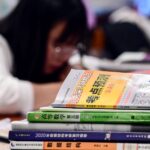
Growing research is starting to show that the use of certain technology in the classroom can actually have negative effects on student learning.
Many schools have now replaced hard copies of textbooks with electronic tablets, including some in Ireland, where the trend is on the rise.
Dr Ann Marcus-Quinn, lecturer in Technical Communication and Instructional Design at the University of Limerick, said that international research proves that “crucial skills such as the ability to empathise and critically analyse texts may be compromised by a shift to reading texts on tablets.”
She warned that simply replacing textbooks with technology may be actually damaging to a child’s ability to learn, as reported by RTE.
“She said such a move replaces the deep reading process which the reader of a hard copy text experiences, with “skim” reading, where the reader looks out for key words and may believe that they are fully absorbing the text but in fact are not.”

Reading from iPads instead of books can impact a child’s ability to comprehend the material. Source: Shutterstock
Dr Marcus-Quinn said that while we may think we are processing information in the same way, in reality, our ability to “empathise and critically analyse the text are all being compromised”, which has huge societal implications.
While reading on tablets is fine for some types of short-form text and reading exercises, it fails to deliver the level of immersion that leads to deep comprehension.
Dr-Marcus Quinn also advised against the “whole school approach” – where schools make a central decision to use electronic devices such as tablets in classrooms across the entire school or across different levels of learning.
“Citing ongoing studies led by Norwegian researchers, but involving academics in 30 countries, Dr Marcus- Quinn said it is vital that teachers are allowed to decide which blend of learning is most suited to their own students in their class.”
OxfordLearning highlighted the fact that there are many advantages and disadvantages to using tablets, but ultimately, textbooks should take precedence.
“The most important part of the learning process is giving students the chance to connect ideas with what they see in front of them. Textbooks provide students a physical approach to learning and help them process information in a way that is easier than on a screen. Students are also able to see their progress right in front of them and understand what they’re accomplishing as they’re learning.”
The use of technology in the classroom remains important and can definitely supplement and enhance a student’s learning experience, but in order to learn effectively, textbooks should still be used as a central focus in learning.
Digital textbooks in the classroom #cartoon #humor #iPad http://t.co/K1FUYZRwgv pic.twitter.com/pMsQorEJY0
— Piotr Kowalczyk (@namenick) September 16, 2014
A study in 2015 also found similar results, where key findings shed new light on the differences between reading printed material and online.
Researchers found that while students preferred to read digitally and that their reading was significantly faster online, overall comprehension was found to be better for print.
While either medium was fine for understanding general information, like the main idea of the text, comprehension was significantly better when it came to specific questions with printed text compared to reading digitally.
What can teachers and schools learn from this? Don’t be too quick to replace textbooks with technology but rather, consider the pros and cons and allow for more flexibility when it comes to learning.
While the use of iPads for learning can certainly be beneficial as they can be easily updated, hold more information in a light device and train kids for a computer-driven future, educators should be aware of the drawbacks.
Using a mix of technology and traditional methods, depending on which works best according to the situation or subject, could be less damaging on their learning capacities and lead to better reading comprehension.







